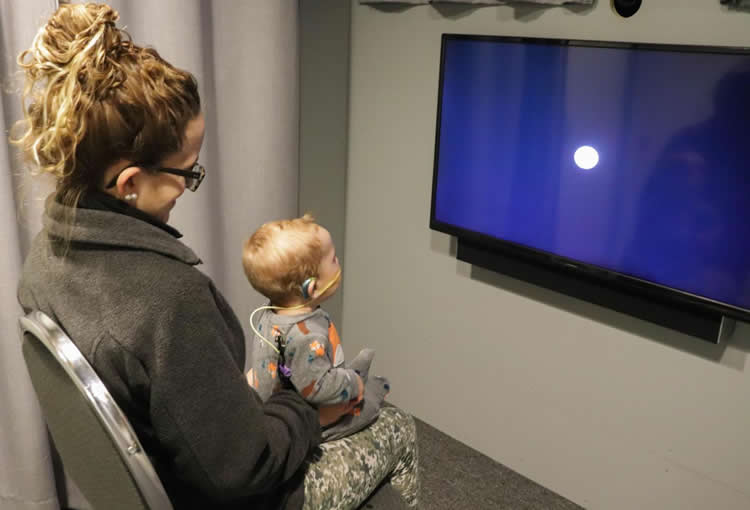Summary: A new study reports it takes longer for deaf infants to become familiar with new objects. Researchers say the study highlights a difference in how infants process information, even when the information is not auditory in nature.
Source: Ohio State University.
Differences in cognitive development between hearing and deaf children start in infancy, according to new research by The Ohio State University College of Medicine published today in the journal PLOS ONE.
While there is a growing body of research in preschool and school-age children that provides evidence of differences in cognitive abilities between deaf and hearing children, researchers at The Ohio State University Wexner Medical Center wanted to know when those differences emerge.
To do this, study co-authors Claire Monroy, post-doctoral otolaryngology fellow, and Derek Houston, associate professor of otolaryngology, became the first to compare visual processing skills in hearing and deaf infants. They found it takes longer for deaf infants to habituate or become familiar with new objects, which highlights a difference in how the infants process information, even when the information is not auditory in nature.
“This research lays the foundation for further exploration into the causes of these differences and their implications,” said Dr. K. Craig Kent, dean of the College of Medicine.
When a baby successfully encodes a visual object, they lose interest and look away. To test their visual processing skills, researchers showed 23 deaf infants and 23 hearing infants ages 7 to 22 months a colorful object on a screen. Deaf infant looking times were 30 seconds longer than hearing infants and the deaf infant look-away rate was approximately 40% lower than hearing infants.
“This is somewhat counterintuitive because a lot of people assume that deaf children compensate for their lack of hearing by being better at processing visual things, but the findings of the study show the opposite,” Monroy said.

However, researchers say the results don’t necessarily mean that deaf children are learning at a slower pace.
“Because they use vision to process the world around them, they may pay closer attention to visual objects,” Houston said. “They might actually be processing more about each object.”
Future research will examine why these differences in visual learning exist so that each child is taught in a way that works best for them and helps them reach their full potential.
“Understanding the source of these differences can really help us tailor interventions specifically for these children,” Monroy said. “And the earlier that happens, the better.”
Source: Drew Schaar – Ohio State University
Publisher: Organized by NeuroscienceNews.com.
Image Source: NeuroscienceNews.com image is credited to The Ohio State University Wexner Medical Center.
Original Research: Open access research for “Visual habituation in deaf and hearing infants” by Claire Monroy, Carissa Shafto, Irina Castellanos, Tonya Bergeson, Derek Houston in PLOS ONE. Published February 6 2019.
doi:10.1371/journal.pone.0209265
[cbtabs][cbtab title=”MLA”]Ohio State University”Hearing and Deaf Infants Process Information Differently.” NeuroscienceNews. NeuroscienceNews, 6 February 2019.
<https://neurosciencenews.com/information-processing-hearing-deaf-10701/>.[/cbtab][cbtab title=”APA”]Ohio State University(2019, February 6). Hearing and Deaf Infants Process Information Differently. NeuroscienceNews. Retrieved February 6, 2019 from https://neurosciencenews.com/information-processing-hearing-deaf-10701/[/cbtab][cbtab title=”Chicago”]Ohio State University”Hearing and Deaf Infants Process Information Differently.” https://neurosciencenews.com/information-processing-hearing-deaf-10701/ (accessed February 6, 2019).[/cbtab][/cbtabs]
Abstract
Visual habituation in deaf and hearing infants
Early cognitive development relies on the sensory experiences that infants acquire as they explore their environment. Atypical experience in one sensory modality from birth may result in fundamental differences in general cognitive abilities. The primary aim of the current study was to compare visual habituation in infants with profound hearing loss, prior to receiving cochlear implants (CIs), and age-matched peers with typical hearing. Two complementary measures of cognitive function and attention maintenance were assessed: the length of time to habituate to a visual stimulus, and look-away rate during habituation. Findings revealed that deaf infants were slower to habituate to a visual stimulus and demonstrated a lower look-away rate than hearing infants. For deaf infants, habituation measures correlated with language outcomes on standardized assessments before cochlear implantation. These findings are consistent with prior evidence suggesting that habituation and look-away rates reflect efficiency of information processing and may suggest that deaf infants take longer to process visual stimuli relative to the hearing infants. Taken together, these findings are consistent with the hypothesis that hearing loss early in infancy influences aspects of general cognitive functioning.






